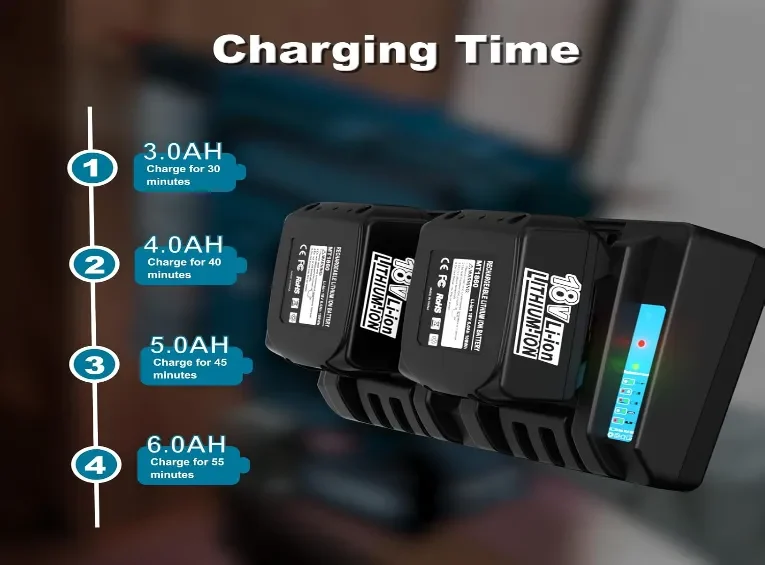How Temperature Affects Makita Charger Performance
Temperature affects both chargers and batteries. Cold packs resist charging, risking lithium plating if forced; hot packs charge faster but stress cells and electronics, increasing faults and shortening lifespan. This guide provides field-tested workflows and fleet tips for safe, efficient charging.

Temperature Effects — Quick Reference
| Temperature Range | Charger Behavior | Battery Behavior | Action Required |
|---|---|---|---|
| <5 °C / 41 °F | “Temp-wait” LED; slow startup | High internal resistance; risk of lithium plating | Pre-warm packs, avoid fast-charge |
| 5–40 °C / 41–104 °F | Normal operation | Optimal charging efficiency | Standard charging workflow |
| 40–45 °C / 104–113 °F | Throttling; slower current | Increased stress; accelerated aging | Monitor closely, ensure ventilation |
| >45–50 °C / 113–122 °F surface | Stop charging; thermal trips | High-risk for damage or fire | Stop, isolate, troubleshoot |
What Happens Inside
-
Cold: Ions move slowly → higher internal resistance → longer charge times. Forcing charge can cause metallic lithium plating, which permanently reduces capacity. Chargers use thermistor/BMS feedback to delay charging automatically.
-
Heat: Faster ion movement accelerates SEI growth and electrolyte decomposition. Charger components (capacitors, transformers, MOSFETs) are stressed, increasing fault probability and reducing service life.
Charger Behavior by Temperature
-
Cold ambient: Charger may not start; “temp-wait” LED is common. Low-temperature components can behave unpredictably.
-
High ambient / heavy load: Thermal throttling triggers; current reduced or paused.
-
Repeated thermal trips: Indicates charger stress or faulty packs; investigate before continuing operation.
Practical Field Thresholds
-
Minimum safe ambient: ~5 °C (41 °F)
-
Normal operating band: 5–40 °C (41–104 °F)
-
Caution zone: 40–45 °C (104–113 °F)
-
Stop / quarantine: >45–50 °C (113–122 °F) surface
Recognizing Temperature-Related Issues
-
“Temp-wait” LED active
-
Alternating or early fault LEDs
-
Intermittent charging or premature termination
-
Hot or cold batteries with smell or smoke
-
Abnormally long charge cycles
On-Site Actions & Best Practices
-
Pre-warm cold packs in insulated pouches or heated toolboxes.
-
Pre-cool hot packs in shaded, ventilated areas.
-
Respect LED indicators and fault codes.
-
Avoid fast-charging cold packs; use slow or conditioning modes if available.
-
Maintain 10–15 cm clearance around charger vents.
-
Spot-check surface temperature with an IR thermometer during the first 5–10 minutes of charging.
Troubleshooting Checklist
-
Cold-fault LED: Warm pack, retry charge
-
Hot-fault LED: Cool pack; check recent heavy usage or sun exposure
-
Pack >45 °C: Stop, isolate, test on another charger
-
Charger overheating: Stagger charges, improve airflow, reduce consecutive fast-charge cycles
Fleet & Cold-Weather Management
-
Keep pre-warmed spare packs ready for crews in winter.
-
Use heated charging stations in extreme cold environments.
-
Label and rotate packs exposed to temperature extremes.
-
Train staff to monitor LEDs, pre-warm packs, and log temperature-related events.
Long-Term Implications
-
Cold charging → lithium plating → permanent capacity loss & safety risk
-
Repeated hot or rapid charging → accelerated aging of both batteries and chargers
-
Adhering to temperature best practices is cost-effective and extends operational life
Tools & Equipment
-
IR thermometer: Check surface temperature
-
Multimeter: OCV/load tests to detect temperature-induced damage
-
Insulated pouch / heated toolbox: Pre-warming of spares
Safety Reminders
-
Stop and isolate swollen, hot, smoky, or odorous packs
-
Follow hazardous-waste protocols
-
Never bypass temperature protections — they prevent irreversible damage and fire
FAQ
Q: Maximum safe temperature for Makita charger?
A: If it becomes too hot to touch comfortably, unplug and allow it to cool in a ventilated area; avoid prolonged operation in high temperatures.
Q: Can fans help?
A: Yes, airflow improves performance and longevity under heavy use.
Q: Are aftermarket chargers safe under temperature extremes?
A: Only robustly designed chargers with proper thermal management maintain safety and performance; inexpensive units may lack protections.
Conclusion
Cold charging slows the process and risks lithium plating; heat accelerates wear and stresses electronics. Monitor both ambient and pack temperatures, respect charger protections, pre-condition packs when needed, and use IR checks for safe, reliable operation. Proper temperature management is the simplest and most effective way to maximize charger and battery lifespan.